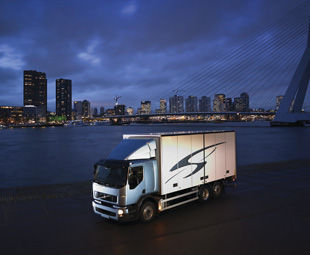The gas alternative – gaining ground

In his monthly review of global news for local truckers, FRANK BEETON looks at some new developments in gas-fuelled trucks, and discusses their relevance to local operators, examines Hino’s Australian “hot rod” light truck and its cheeky advertising campaign, recalls a once-famous name that lives on in a new guise, and details MAN’s new top-of-the-range Euro-6 engine.
Earlier this year, we learnt about the moving out of the July 1, 2017 compliance date for the general introduction of new cleaner fuels in South Africa, and noted speculation that the legislation might only take effect in 2020. It followed that this delay would have a negative impact on the introduction of some new-technology vehicles into the local market, a fact subsequently confirmed in published comments from Kobus van Zyl, managing director of Daimler Trucks and Buses South Africa.
Although some short-term relief was provided by Sasol’s launch of its ULS 10 parts per million (ppm) diesel fuel through outlets in Gauteng and Mpumalanga, the lack of wider availability of this fuel would inevitably limit the vehicle purchasing options of transporters with a broader operational footprint, especially those working in the more remote areas of the country and across its borders.
However, comments made at the Gas Week conference held in Bryanston, Johannesburg, during June – and subsequently reinforced by the South African Oil and Gas Alliance – suggested an alternative long-term direction for solving the problem. They put forward the view that South Africa should be focusing more attention on gas developments to secure its future fuel requirements.
Extensive natural gas resources are known to be present in the region. These include recently discovered coal-bed methane deposits in Botswana, the shale gas deposits in the Karoo that are central to the ongoing “fracking” debate, and natural gas deposits off the Mozambique coastline.
There is a perception that further discoveries are likely to be made in the future that will greatly increase the region’s importance as a gas producer. However, exploration and extraction is expected to be expensive, and substantial investments will be necessary to roll out the process.
Natural Gas, in either liquefied (LNG) or compressed (CNG) form, is widely used as a vehicle fuel, with the main markets reportedly being in Iran, Pakistan, Argentina, Brazil and China. Many major vehicle manufacturers offer versions of their products that are adapted to run on CNG or LNG. Other specialist companies, notably Westport of British Columbia, are active in the business of converting conventional engines for operation on gas fuels.
In South Africa, natural gas from Mossel Bay and Mozambique currently constitutes only about two percent of the energy mix. Globally, natural gas-fuelled vehicles are gaining popularity in city and suburban passenger and goods-carrying applications, because of their lower emissions. A project to convert 1 000 minibus taxis to CNG operation was recently inaugurated in Johannesburg.
 Fuel distribution and availability are the greatest challenges to the wider use of natural gas as a vehicle fuel, and the existence of fuelling facilities in major centres is another reason for the present urban concentration of gas-fuelled vehicles.
Fuel distribution and availability are the greatest challenges to the wider use of natural gas as a vehicle fuel, and the existence of fuelling facilities in major centres is another reason for the present urban concentration of gas-fuelled vehicles.
Recently, there have been a number of introductions of new gas-fuelled products from global commercial vehicle manufacturers. Mercedes-Benz has announced the availability of the M 936 G natural gas engine in its recently refreshed Econic range of specialist low-entry waste collection and short-radius distribution vehicles. This six-cylinder, in-line powerplant is based on the 7,7-litre OM 936 turbodiesel, producing similar outputs of 222 kW (302 hp) and 1 200 Nm in CNG-fuelled format.
Unique components for the CNG version include an asymmetrical turbine turbocharger, charge-air ducting, a spark-plug and coil-ignition system, exhaust gas recirculation equipment and lightweight carbon-fibre-encased steel gas cylinders.
The inherently soot-free combustion characteristics of the gas engine have obviated the need for a particulate filter, leaving exhaust emissions to be processed through a three-way catalytic converter.
This power unit is claimed to be quieter than its diesel counterpart across the entire engine speed range. Features and specifications of the latest Econic line-up were detailed in the June 2013 FOCUS, and the CNG-fuelled NGT version continues to follow that general description.
Last July, we reported on the latest updates to Volvo Trucks’s FE and FL distribution specialist ranges, and their newly adopted
5,1-litre D5 and 7,7-litre D8 global engine family diesel power plants.
This year, Volvo has launched a methane gas-fuelled version of the FE range, designated FE CNG, which is primarily intended for short driving cycles involving frequent stop-starts, including refuse collection and local distribution duties. (Methane is the generic name for both natural gas and biogas, with the former emanating from deposits beneath the earth’s crust, while the latter is extracted from decomposed organic material.)
The Volvo FE CNG is equipped with a short day cab, and uses an all-new, nine-litre G9K Euro-6 engine fitted with spark-plug technology, producing power and torque outputs of 240 kW (320 hp) and 1 356 Nm, respectively. The engine draws fuel from a 160 m³ fuel tank and is partnered by a six-speed fully automatic transmission.
Meanwhile, in Brazil, MAN Latin America has put a CNG-fuelled Volkswagen Constellation 24.280 prototype into service on a six-month trial with transport operator Coopercarga, delivering beverages in central Rio de Janeiro.
This vehicle, which is powered by an MAN E0836 engine imported from Germany, delivered pre-service test results suggesting that it will return significant fuel consumption, CO2 emissions and noise-level benefits over the equivalent diesel model. MAN reports substantial interest in the possibility of operating CNG fuelled trucks among fleet owners in Brazil, Peru, Bolivia, Mexico and Venezuela.
From a local perspective, the delay in the phasing-in of Euro-5-type fuels in South Africa will add additional momentum to local arguments in favour of gas as an alternative. Presently, the lack of a comprehensive distribution system for any form of gas-based fuel in the country is an obstacle, but its protagonists are advocating shorter-term importation of natural gas, ahead of large-scale local or regional exploitation, in order to develop the market for this type of fuel.
Wider use of CNG by the taxi industry, and some adoption of this fuel by city and suburban bus fleets, could also be supportive developments. Clean fuel availability is becoming a key issue in ensuring the safe, environmentally acceptable and sustainable operation of transport, and the country needs a clear and affordable strategy going forward to achieve these goals.
Hino’s Aussie Hot Rod
Australia’s light-duty truck market – 3 500 to 8 000 kg gross vehicle mass (GVM) – is very similar to South Africa’s medium commercial vehicle (MCV) market segment (3 500 to 8 500 kg GVM), with the important difference being that it excludes integral panel vans, which are reported separately “down under”.
In 2013, Australian light-duty truck sales totalled 8 550 units, and the suppliers were headed up by Isuzu (38 percent market share), Fuso (21,8 percent share) and Hino (20,3 percent share). This makes it an important battleground for these Japanese brands, and Isuzu’s dominant position in light trucks has contributed significantly to its overall leadership of the Australian truck market for the past 25 consecutive years.
Consequently, major efforts are being made by Japanese manufacturers to provide Australian operators with exactly the vehicles that they want, and specification levels are constantly on the rise. Features now to be found regularly on Australian market light trucks include state-of-the-art entertainment systems, satellite navigation, reversing cameras, ABS, disc brakes and stability control.
As can be seen from the 2013 results, Hino has some catching up to do. The Toyota-owned company has frequently stated its intention to chase down Number One in the Aussie market, so an aggressive approach to light truck marketing is an important component of that strategy.
Earlier this year, Hino shook up the status quo by putting a five-litre JO5E engine, developing 151 kW, and 600 Nm of torque, into a 300 Series truck. That’s right, a 205 hp engine in a truck rated at 8,5 t GVM, or even in a 4,5 t GVM version that is also available for operation with a car driver’s licence! By way of comparison, the equivalent South African 915 model has a four-litre engine rated at 110 kW (147 hp).
The Aussie line-up includes the 920 model, which has its JO5E engine down rated to 139 kW (189 hp)/510 Nm (still very substantial outputs in this mass class) and is equipped with Hino’s MZZ6F six-speed manual transmission, and the 921 with fully rated, five-litre engine and Aisin A465 six-speed automatic gearbox.
The fact that the top power output is available only in the automatic transmission version is interesting, and follows the lead of some manufacturers at the top end of the heavy-duty market that will only pair their most powerful engines with automated transmissions, thus protecting their drivelines from the ravages of over-zealous driving!
Clearly, with these flagship 300 Series models, Hino has set out to create a “driver’s truck”, and has included features such as overdrive ratios in both transmissions, a suspended driver’s seat, dual airbags, an entertainment system and vehicle stability control in the specifications.
Hino’s advertising of this premium light truck can only be described as “interesting”. The ad shows a 921 chassis engaged in a tug-of-war with another truck of similar size, facing away from the camera to hide any identification. However, any knowledgeable observer would immediately recognise its distinctive cab shape as being that of the market leader!
Although no comment is offered, the Hino looks extremely composed, apparently winning the battle, while the competitor is wreathed in smoke, presumably coming from its spinning tyres being pulled mercilessly backwards. The ad’s headline reads: “Australia’s most powerful light-duty truck. And it’s an auto”. Provocative, indeed!
What’s happening at Leyland?
There was a time when the town of Leyland, in the English county of Lancashire, the home of Leyland Motors Limited, would have been many people’s choice as “heavy truck and bus capital of the world”. This was certainly the case in the 1950s, before the ill-fated consolidation of the once great British motor industry gained momentum and became a self-consuming rush to virtual extinction.
 Just to recap, that process had started as early as 1925, and eventually encompassed a whole slew of iconic car, truck and bus brands including Leyland, Albion, Scammell, AEC, Thornycroft, Aveling-Barford, Guy, Daimler, Triumph, Rover, Jaguar, Austin, Morris, Wolseley, MG, Riley and Bristol.
Just to recap, that process had started as early as 1925, and eventually encompassed a whole slew of iconic car, truck and bus brands including Leyland, Albion, Scammell, AEC, Thornycroft, Aveling-Barford, Guy, Daimler, Triumph, Rover, Jaguar, Austin, Morris, Wolseley, MG, Riley and Bristol.
The end result was the breaking up of the British Leyland empire (which had been politically engineered to contain all of the aforementioned), and the sale of most of its remaining constituents to foreign capital. Alas, many of them did not survive the process, and today, the Leyland “Catherine wheel” logo can only be seen adorning Indian Ashok Leyland products.
However, Leyland’s name does still live on in the commercial vehicle industry, as Leyland Trucks Limited, but not as a vehicle brand. Since 1998, it has been a subsidiary of American trucking family Paccar Inc, and is today the United Kingdom (UK) production and development base of that group.
The company currently employs more than 750 people, and its facilities occupy 60 000 m² of space in the famous town. These include a parts distribution centre, and a design and development facility employing 100 engineers.
During July, Leyland Trucks celebrated the production of the 125 000th DAF LF light to medium-duty truck – with these products having been supplied to the UK, European, Israeli, Malaysian, Australian and South American markets.
The Leyland operation’s current production includes Euro-6 DAF LF’s, covering the GVM spectrum from 7,5 to 18 t,
and powered by four and six-cylinder Paccar PX engines.
MAN’s new engine
At the end of June, MAN Truck and Bus revealed details of its new D3876 engine (which you might have read about on page 25 of FOCUS October), prior to its appearance in the TGX 41.640 8×4 heavy-duty truck-tractor at the 2014 IAA show in Hanover (see page 14).
This six-cylinder in-line diesel, which displaces 15,2 litres, can produce outputs of up to 480 kW (640 hp), and 3 000 Nm, and is the flagship of MAN’s Euro-6-compliant engine line-up.
The TGX 41.640 is capable of working at gross combination mass (GCM) of up to 250 t, and, as part of MAN’s new TGX D38 truck range, is equipped with a new-generation TipMatic 2, 12-speed automated transmission, GPS-controlled cruise-control system, Electronic Stability Programme, Emergency Brake Assist, Lane Guard System, and Adaptive Cruise Control.
Other D38 features include XL, XLX and XXL cab sizes, left or right-hand steering, and a selection of axle/drive configurations including 4×2, 6×2 with mid or rearmost drive axles, 6×4 tandem drive, and 8×4 tandem drive.
The D3876 engine has a number of interesting design features. The engine is constructed from a number of different materials, with the block and cylinder head made of cast iron with vermicular graphite, the flywheel housing of aluminium, and the sump and rocker cover of plastic construction. The cooling system is described as “top-down”, with the liquid coolant pumped through the engine from top to bottom, giving priority to high thermal stress areas such as the injectors and exhaust valves.
The system is also claimed to ensure even cooling of all cylinders, drawing less engine power for the operation of the coolant pump. The engine also employs domed valves, claimed to be a first for truck diesels, which reduce distortion of the valve head at the seating ring. The pistons are manufactured from forged steel, enabling the use of shorter pistons with longer connecting rods, resulting in reduced surface contact between piston and cylinder liner wall, and less wear.
The D3876 induction system consists of two-stage exhaust turbocharging, and two-stage charge air cooling. The two differently sized turbochargers are connected in series, with the smaller, high-pressure unit tasked to optimise low-speed response, while the larger unit comes more into play at higher speeds and loads.
The third-generation, common-rail fuel-injection system operates at pressures of up to 2 500 bar, providing pre-, main- and post-injection events. Euro-6 emissions compliance has been achieved through a combination of cooled external high-pressure exhaust gas recirculation, selective catalytic reduction, and a closed particulate filter employing continuously regenerating technology. MAN claims that this combination reduces AdBlue usage by 60 percent when compared to a Euro-5 installation.
The engine also has foam-filled encapsulated cable harnesses to eliminate vibration fatigue, and a demand controlled two-cylinder air compressor of 476 cc displacement, which is brought into operation only when required. Engine braking is provided by an exhaust valve brake (340 kW retardation at 2 400 r/min), or a Turbo EVB, which increases the retardation level to 600 kW at 2 400 r/min.
Last December, we asked: “Has Euro 6 put the lid on the power race at the top of the global truck market?” The arrival of the D3876 may have provided a partial answer to that question, as it is less powerful than MAN’s 500 kW (680 hp) D28 engine, launched as far back as 2007.
However, this new engine is also claimed to be 160 kg lighter than the Euro-5 D28 V8, so an argument can be made in favour of greater efficiency.
For the time being, however, it seems that Volvo Trucks’s 551 kW (750 hp) FH16 will retain the title of “world’s most powerful truck” that it gained in September 2011, until a new Euro-6 champion is crowned.
Global FOCUS is a monthly update of international news relating to the commercial vehicle industry. It is compiled exclusively for FOCUS by Frank Beeton of Econometrix.
Published by
Focus on Transport
focusmagsa




